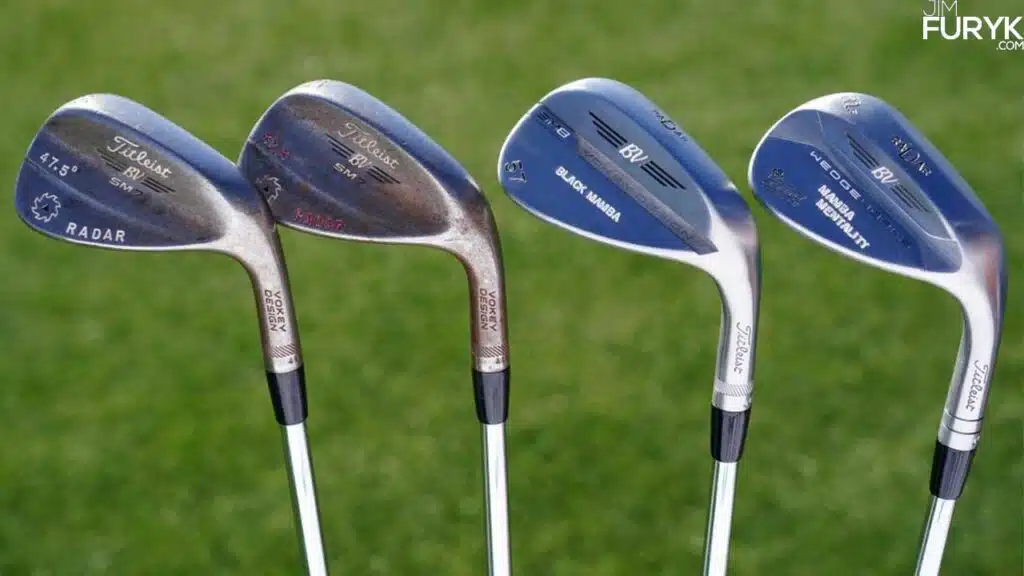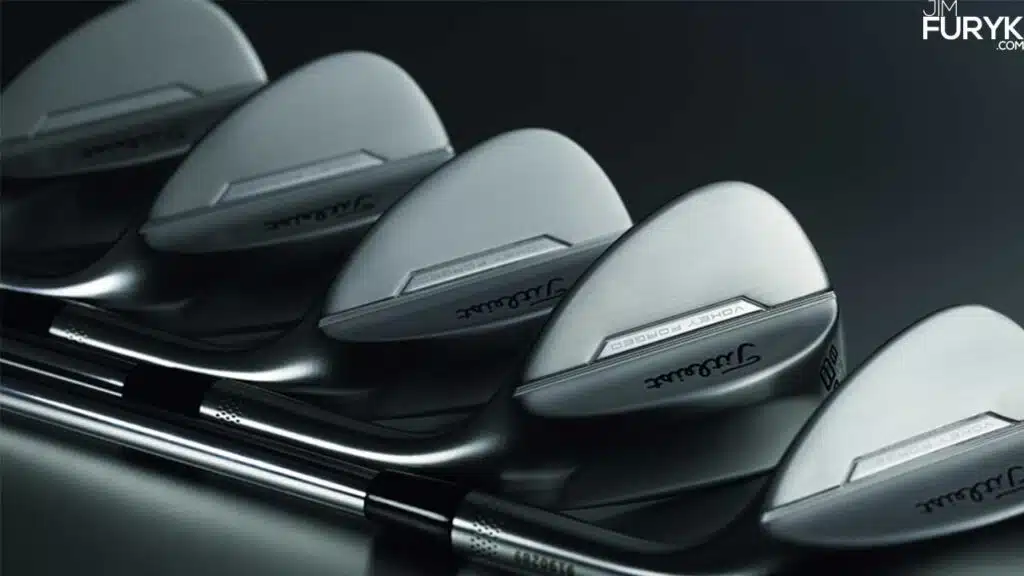I still remember the first time I picked up a golf club. It felt like holding a key to an entirely new world, a world full of potential and possibilities.
As I started my journey, I was overwhelmed by the range of golf clubs available – from drivers to putters, each with its unique purpose and design. One of the golf clubs that I found particularly intriguing was the pitching wedge.
It seemed to be one of the most versatile tools in my golf bag, but I was puzzled about one aspect – what degree is a pitching wedge, and why does it matter?
This was not a question I could ignore. The loft of a golf club – significantly affects how the ball behaves once struck.
In the following sections, we’ll start by understanding what exactly a pitching wedge is and its role on the golf course. Then, we’ll talk about the typical loft degree of a pitching wedge and why it’s important. So, let’s get started.

In This Post
- What is Loft in Golf?
- Understanding Pitching Wedges
- Different Types of Golf Wedges
- Importance of Loft and Shot Combination
- Pitching Wedge Loft
- The Importance of Pitching Wedge Loft in Your Golf Game
- Analyzing Your Pitching Wedge Loft and Gapping
- Using a Pitching Wedge Effectively
- Understanding Other Wedge Options
- Factors Affecting Pitching Wedge Distance
- Choosing the Right Pitching Wedge Loft for Your Game
- Conclusion
What is Loft in Golf?
The “loft” or “loft angle” refers to the angle of the clubface. It is the angle between the face of the club and a vertical plane. I have a more detailed article on “Loft”, which you can read here.
It plays a significant role in determining the trajectory and distance of your shots. In general, clubs with more loft will produce higher and shorter shots, while clubs with less loft will lead to lower and longer shots.
Understanding Pitching Wedges
Pitching wedges are one of the most frequently used clubs in a golfer’s bag. They are designed to offer a combination of distance and control, making them ideal for approach shots and delicate shots around the green. The pitching wedge is usually one of the shortest clubs in a golfer’s set, with a slightly higher loft compared to other irons.
Different Types of Golf Wedges
Before delving into the specifics of pitching wedge loft, let’s briefly explore the different types of golf wedges and their unique purposes. Among the most common types are the sand wedge, gap (or approach) wedge, and lob wedge.
-
The sand wedge is characterized by its high loft and wide sole, making it an indispensable tool for escaping greenside bunkers with ease.
-
The gap wedge, also known as the approach wedge, fills the gap between the pitching wedge and the sand wedge, providing versatility in distance and shot-making options.
-
The lob wedge has the highest loft of all wedges and is perfect for executing high, soft shots, particularly when you need to clear hazards or stop the ball quickly on the green.
Importance of Loft and Shot Combination
The combination of loft and shot execution is pivotal in golf, and the pitching wedge plays a crucial role in this context. Let me illustrate with an example: imagine you are faced with a 100-yard approach shot to the green. By using your pitching wedge with its loft, you can control the trajectory and spin of the ball to land it softly on the green and prevent it from rolling too far.
Pitching Wedge Loft
To understand how the pitching wedge loft affects your game, it’s essential to know its degree.
Most pitching wedges have a loft ranging from 44 to 48 degrees, with some variations among different club manufacturers. For instance, TaylorMade’s pitching wedge loft may differ slightly from Callaway’s.
Understanding the concept of a “strong” and “weak” pitching wedge loft is also valuable. A “strong” pitching wedge has a lower loft angle (e.g., 44 degrees), making it more suitable for longer distance shots, while a “weak” pitching wedge has a higher loft angle (e.g., 48 degrees), allowing for greater control on shorter shots.
In recent years, some manufacturers have made the lofts of their pitching wedges stronger to increase distance, particularly in game improvement iron sets.

The Importance of Pitching Wedge Loft in Your Golf Game
The loft of your pitching wedge plays a significant role in determining the trajectory, spin, and distance of your shots. A higher lofted pitching wedge will naturally produce higher shots with more spin, while a lower lofted pitching wedge will result in lower shots with less spin.
Understanding the loft of your pitching wedge and how it impacts your game will help you make better decisions when approaching the green and selecting the right club for the shot.
Learn How to Hit A Pitching Wedge – Different Pitching Wedge Uses here.
Factors Affecting Pitching Wedge Loft
Several factors can affect the loft of your pitching wedge, including:
- Club Manufacturer: Different golf club manufacturers may produce pitching wedges with varying degrees of loft. It’s essential to know the loft of your specific pitching wedge and how it compares to other clubs in your bag.
- Club Type: The type of club you use can also impact the loft of your pitching wedge. For example, game improvement iron sets typically have stronger lofts to help increase distance, while blade-style players type wedges may have lofts closer to the traditional range.
- Customization: Some golfers may choose to customize their pitching wedge loft to better suit their game. This can be done by adjusting the club’s loft angle through a process known as bending. However, this should only be done by a qualified club fitter and within the recommended limits to avoid damaging the club.
Analyzing Your Pitching Wedge Loft and Gapping
To properly optimize your wedge set, it’s crucial to understand the loft of your pitching wedge and ensure proper gapping with your other wedges. This can be done through the following steps:
-
- Determine Your Pitching Wedge Loft: Research your club’s specifications on the manufacturer’s website or consult a club fitter to determine the current loft of your pitching wedge.
- Evaluate Your Wedge Set: Examine the lofts of your other wedges (gap wedge, sand wedge, and lob wedge) and ensure they are evenly spaced and blend well with your pitching wedge. Ideally, you should have a gap of around 4-6 degrees between each wedge.
- Adjust Lofts if Necessary: If you find that your wedge lofts are not properly gapped, consider adjusting the lofts of your wedges through bending or replacing them with wedges that have the correct lofts to achieve proper gapping.

Using a Pitching Wedge Effectively
Knowing when and how to use a pitching wedge effectively can significantly impact your golf game. For approach shots, the pitching wedge shines when you are within 100 to 120 yards from the green. Its loft enables you to hit the ball high and land it softly, reducing the risk of overshooting the target.
To hit a perfect pitch shot with your pitching wedge, remember to open your stance slightly, position the ball in the center of your stance, and maintain a smooth, controlled swing. Practice this technique on the driving range to build confidence in your pitch shots.
Understanding Other Wedge Options
While the pitching wedge is essential, it’s crucial to be aware of other wedge options and their applications. Mastering the sand wedge allows you to handle greenside bunkers with confidence, while the lob wedge comes in handy for those delicate shots that require precision and a high launch angle.
Factors Affecting Pitching Wedge Distance
The distance you can achieve with your pitching wedge is influenced by various factors. Factors like your swing speed, ball striking ability, and course conditions can all impact how far the ball travels with each shot.
It’s essential to understand your personal yardages with each club, including your pitching wedge, to make informed decisions on the course.
Choosing the Right Pitching Wedge Loft for Your Game
To select the ideal pitching wedge loft for your game, consider the following factors:
- Your Playing Style: Think about how you use your pitching wedge in your game. Do you mostly use it for approach shots, or do you also rely on it for greenside shots and pitches? This will help you determine if a higher or lower lofted pitching wedge is more suitable for your playing style.
- Club Set Configuration: The number of wedges you carry in your bag will affect the gapping and loft of your pitching wedge. Most golfers carry three to four wedges, with the pitching wedge being the least lofted club among them. Ensure your wedge set is appropriately gapped and transitions well into your iron set.
- Test Different Pitching Wedges: If possible, try out various pitching wedges with different lofts to determine which one suits your game best. This can be done through demo days, fitting sessions, or practice sessions at facilities like Topgolf.
Conclusion
The loft of a pitching wedge is a critical aspect of golfing that can’t be overlooked. This loft is typically between 45 to 47 degrees, which is a key detail that influences how your ball behaves after it’s hit. This knowledge can empower you to make more accurate and effective swings.
Just remember, even though the club’s specifics are important, golf is a game of precision, skill, and mental fortitude. It’s not just about having the right club – it’s about how you use it.
With all this newfound information, I hope you’re feeling ready and confident to take on your next golfing challenge. Golf is a game full of nuances, and each small detail we learn brings us one step closer to being a master golfer. Here’s to hitting fairways, navigating greens, and making the most of your pitching wedge.
Keep playing, keep learning, and above all, enjoy the game. Golf is an adventure, one where the journey is just as important as the destination. So, grab your pitching wedge, and let’s get back on the course!
References:
